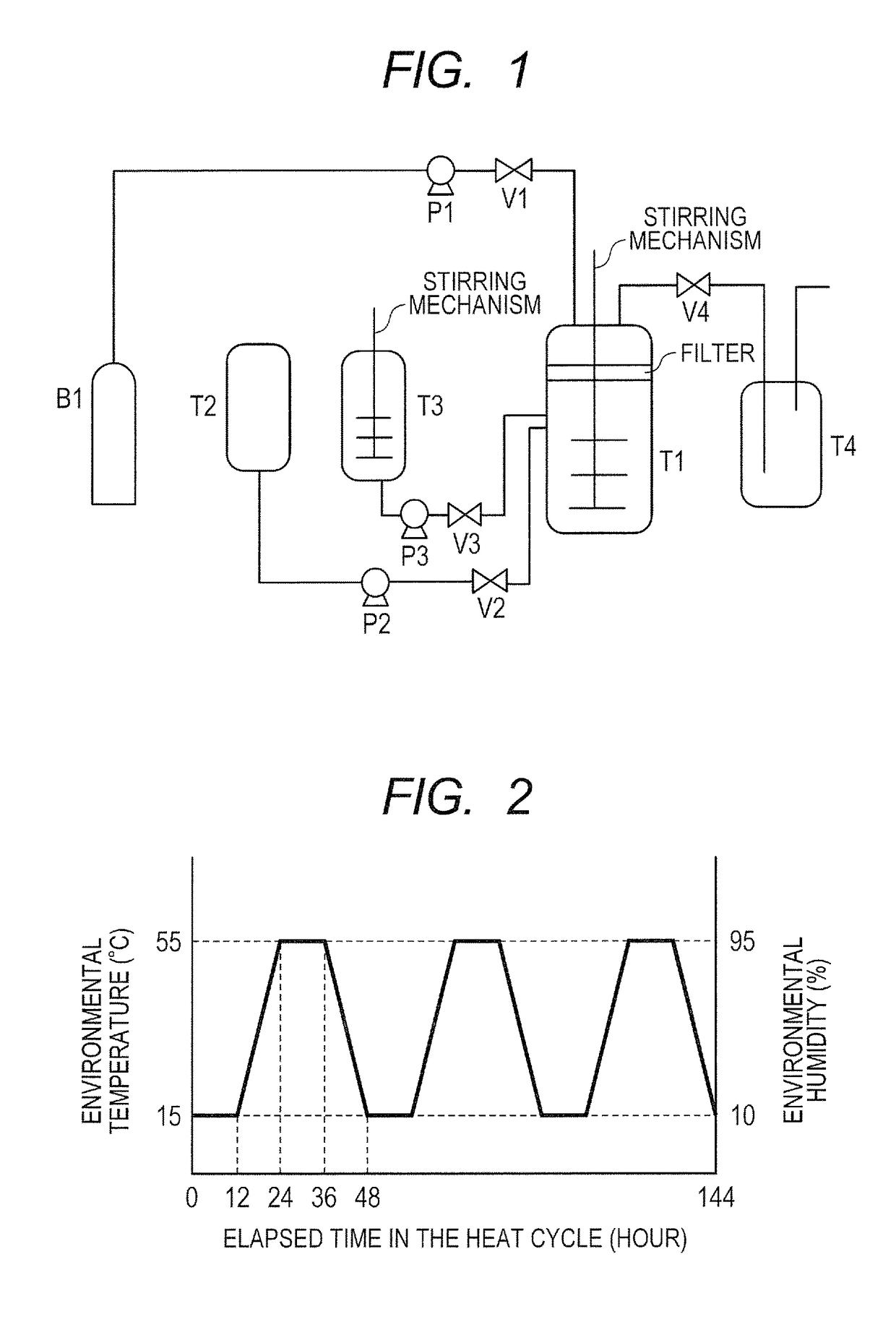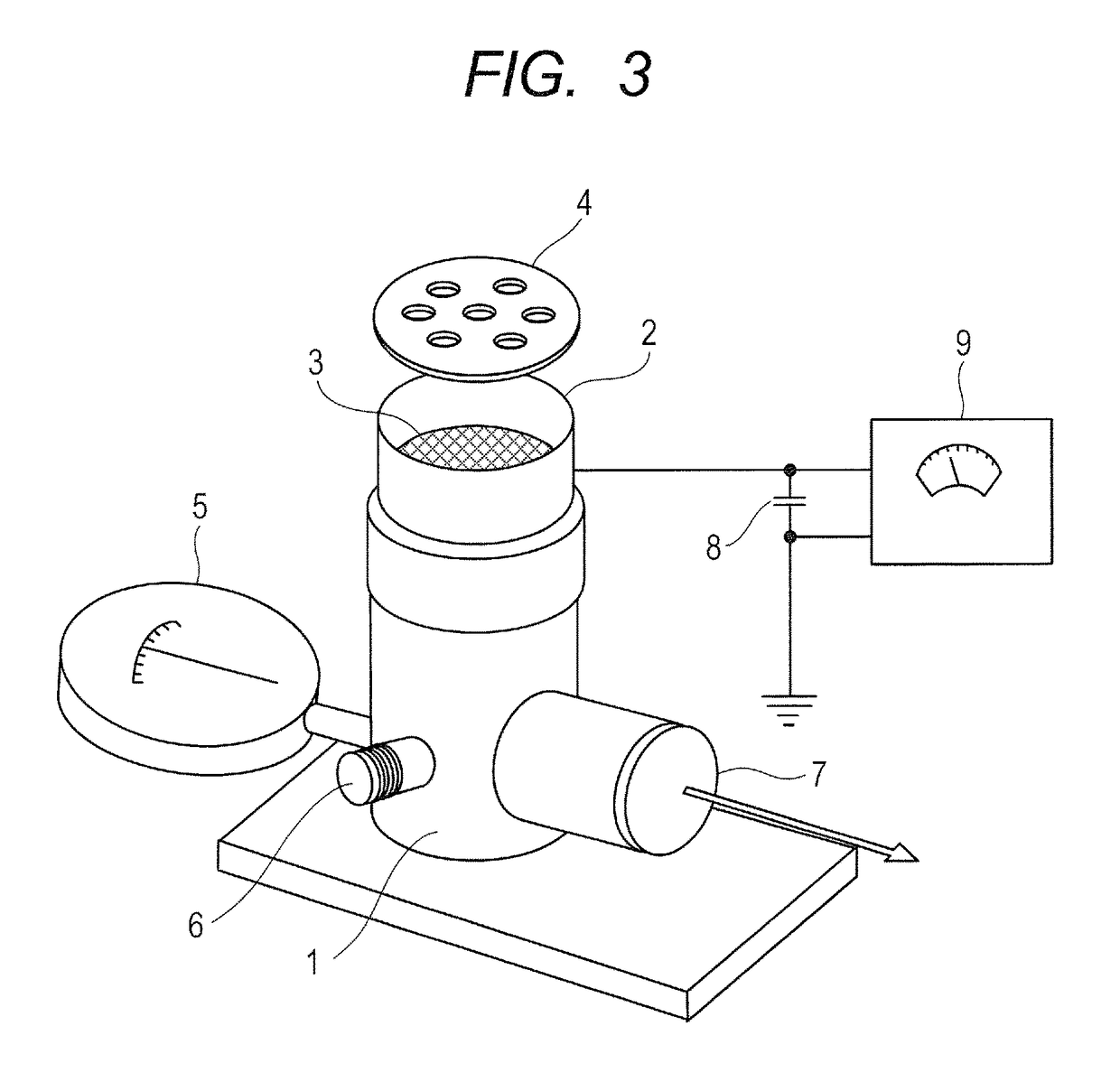Toner
a technology of toner and core resin, applied in the field of toner, can solve the problems of low-temperature fixability, prone to cold offset, and difficult to ensure the heat exchange of the core resin, and achieve excellent low-temperature fixability and storage stability, environmental stability, and durability
- Summary
- Abstract
- Description
- Claims
- Application Information
AI Technical Summary
Benefits of technology
Problems solved by technology
Method used
Image
Examples
example 1
[0319]In an apparatus illustrated in FIG. 1, first, valves V1, V2, and V3 and a pressure-adjusting valve V4 were closed. 18.0 Parts by mass of the resin fine particle dispersion liquid 16 for forming an intermediate layer containing the resin “B” was loaded into a pressure-resistant granulation tank T1 including a filter for capturing toner particle and a stirring mechanism, and the internal temperature of the tank was adjusted to 40° C. Next, the valve V1 was opened, carbon dioxide (purity: 99.99%) was introduced from a carbon dioxide bomb B1 into the granulation tank T1 with a pump P1, and the valve V1 was closed when the internal pressure of the tank reached 2.0 MPa.
[0320]Meanwhile, the block polymer solution 1, the colorant dispersion liquid 1, and the wax dispersion liquid 1 were loaded into a resin solution tank T3 to prepare a resin solution, and then the internal temperature of the tank was adjusted to 40° C. Next, the valve V3 was opened, and the resin solution of the resin...
example 28
[0330]In an apparatus illustrated in FIG. 1, first, valves V1, V2, and V3 and a pressure-adjusting valve V4 were closed. Then, 18.0 parts by mass of the resin fine particle dispersion liquid 16 for forming a first intermediate layer containing the resin “B” was loaded into a pressure-resistant granulation tank T1 including a filter for capturing toner particle and a stirring mechanism, and the internal temperature of the tank was adjusted to 40° C. Next, the valve V1 was opened, carbon dioxide (purity: 99.99%) was introduced from a carbon dioxide bomb B1 into the granulation tank T1 with a pump P1, and the valve V1 was closed when the internal pressure of the tank reached 2.0 MPa.
[0331]Meanwhile, the block polymer solution 1, the colorant dispersion liquid 1, and the wax dispersion liquid 1 were loaded into a resin solution tank T3 to prepare a resin solution, and then the internal temperature of the tank was adjusted to 40° C. Next, the valve V3 was opened, and the resin solution o...
example 29
[0337]In an apparatus illustrated in FIG. 1, first, valves V1, V2, and V3 and a pressure-adjusting valve V4 were closed. Then, 18.0 parts by mass of the resin fine particle dispersion liquid 12 for forming a shell layer containing the resin “A” was loaded into a pressure-resistant granulation tank T1 including a filter for capturing toner particle and a stirring mechanism, and the internal temperature of the tank was adjusted to 40° C. Next, the valve V1 was opened, carbon dioxide (purity: 99.99%) was introduced from a carbon dioxide bomb B1 into the granulation tank T1 with a pump P1, and the valve V1 was closed when the internal pressure of the tank reached 2.0 MPa.
[0338]Meanwhile, the block polymer solution 1, the colorant dispersion liquid 1, and the wax dispersion liquid 1 were loaded into a resin solution tank T3 to prepare a resin solution, and then the internal temperature of the tank was adjusted to 40° C. Next, the valve V3 was opened, and the resin solution of the resin s...
PUM
 Login to View More
Login to View More Abstract
Description
Claims
Application Information
 Login to View More
Login to View More - R&D
- Intellectual Property
- Life Sciences
- Materials
- Tech Scout
- Unparalleled Data Quality
- Higher Quality Content
- 60% Fewer Hallucinations
Browse by: Latest US Patents, China's latest patents, Technical Efficacy Thesaurus, Application Domain, Technology Topic, Popular Technical Reports.
© 2025 PatSnap. All rights reserved.Legal|Privacy policy|Modern Slavery Act Transparency Statement|Sitemap|About US| Contact US: help@patsnap.com



